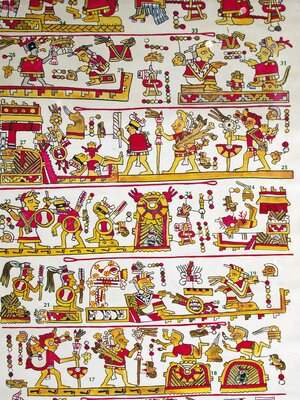
Sign up to save your library
With an OverDrive account, you can save your favorite libraries for at-a-glance information about availability. Find out more about OverDrive accounts.
Find this title in Libby, the library reading app by OverDrive.



Search for a digital library with this title
Title found at these libraries:
| Loading... |
In the heart of ancient Mexico, the Aztec civilization flourished between the 14th and 16th centuries, leaving an indelible mark on human history. Renowned for their magnificence and sophistication, the Aztecs crafted a society that blended advanced architecture, intricate artistry, and profound religious customs.
At the nucleus of their empire stood Tenochtitlan, a city perched on an island in Lake Texcoco, showcasing the Aztec's architectural prowess through an elaborate network of causeways, canals, and bridges. Towering temples, expansive marketplaces, and the awe-inspiring Great Pyramid of Tenochtitlan reflected their urban planning and engineering expertise, symbolizing a spiritual connection to their primary deity, Huitzilopochtli.
Art and culture thrived in Aztec society, with codices and stone carvings preserving historical events and religious beliefs. The Codex Mendoza unveiled the intricacies of their social structure, while exquisite jewelry, pottery, and the vibrant "penacho" headdresses displayed their mastery of design and color.
Religion permeated every facet of Aztec life, with a diverse pantheon of deities embodying natural forces. Central to their beliefs was the sun god, Huitzilopochtli, prompting rituals, including human sacrifices, to honor the gods. Temples and ceremonial centers dotted the empire, serving as focal points for religious activities.
Structured hierarchically, Aztec society featured an emperor at its zenith, followed by nobles, priests, artisans, commoners, and slaves. Education played a pivotal role, with specialized schools preparing individuals for various professions, ensuring governance and order.
Agriculture, supported by ingenious chinampas—floating gardens—enabled the Aztecs to thrive in the challenging terrain of Lake Texcoco. Maize, beans, and squash flourished, sustaining the population and fostering trade.
Tragically, the arrival of Spanish conquistadors, led by Hernán Cortés, in the 16th century marked the downfall of the Aztec civilization. The collision of cultures resulted in the fall of Tenochtitlan in 1521, suppressing and obliterating Aztec art, knowledge, and heritage.
Yet, the legacy of the Aztecs endures in contemporary Mexican culture. Their contributions to architecture, art, agriculture, and religion remain captivating and inspirational, serving as a poignant reminder of the intricacies and brilliance of human history. The memory of the magnificent Aztec civilization beckons us to glean wisdom from the past, valuing the diverse tapestry of cultures that has shaped our world.






